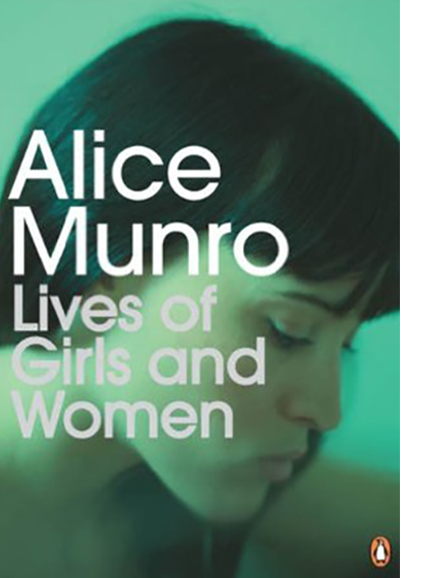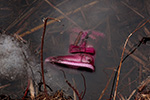by Alice Monroe

Recommended by Anne Giardini
Lives of Girls and Women gives voice to Del, a young woman who journeys from childhood through the awkwardness of adolescence as she comes to realize the woman she does not want to be: one married with children. Set in post-World War II rural Ontario, the novel is a gently written examination of the everyday.
Alongside Del, the reader visits episodes of her life that, as she matures, reveal complex themes of what it means not only to be a woman, but a fully formed and unique adult who grasps opportunities and experiences. It is one woman’s story, and yet also reflects the stories of many.
Click below to download the discussion guide.
Anne Giardini

As a director, writer and lawyer, Anne publishes and speaks on sustainability, ethics, legal, governance and other topics. She has been a weekly columnist for the National Post and a contributor to the bestseller Dropped Threads. Her novels, The Sad Truth About Happiness and Advice for Italian Boys, were published in 2005 and 2009, and Startle and Illuminate, a book of writing advice co-edited with her son Nicholas, was published in May 2016.
In her role as the 11th Chancellor of Simon Fraser University, Anne frequently wears a very large and very red velvet hat. While chancellors in early days could imprison, excommunicate, require penance, deprive a master or scholar of privileges, and determine disputes, today the chancellor is a ceremonial non-resident head of the university.
Anne has been married for 28 years to Tony Giardini and they are the parents of three young adults.
Anne, on her choice for this book
I chose Alice Munro’s Lives of Girls and Women because it is among the essential works of Canadian fiction and because it lays bare the contradictions that make up human nature.
Published in 1971, when Munro was 40, Lives of Girls and Women is the second of her many books, primarily collections of short stories. (She had published her first collection, Dance of the Happy Shades, three years earlier.) A lifetime of extraordinary writing followed. She was awarded the 2013 Nobel Prize for Literature, the Swedish Academy calling her a “master of the contemporary short story.” Her stories range across much of Canada—countryside, small towns, and cities—and span the days of the early settlers to the present. Alice Munro tells us truths, both gorgeous and heartbreaking, about the bounded lives that most of us live.
The central character, observer and narrator in Lives of Girls and Women is the marvelously-named Del Jordan, and it is through her observations that the stories of the people of Jubilee, Ontario, are delivered to us. Del is a meticulous if sometimes unreliable chronicler of these lives, showing them as tightly defined and yet wide open as any to human experience.
The people of Jubilee appear to live simple lives but they are awash in contradictions. Del discerns “malice” beneath “their courtesies”. A sunburned chest is “a V of tough red skin” but “with a tender edge of white.” We are told of a neighbour whose eyes are both delicate and predatory; he adores the animals he raises while also relishing “their unpleasant destinies.” In an old photograph, pioneers wear “fierce but somehow helpless expressions.” While Del’s aunts respect “men’s work beyond anything; they also laughed at it.” The good Christians of Jubilee believe that someone who has died is in a “white nightshirt and floating around Eternity” and at the same time in the ground decaying. Being forgiven is both reassuring and shameful, and remorse is tender, but has “on its other side a brutal, unblemished satisfaction.”
The book ends with Del relieved and desolate. The book’s title comes from a short cautionary lecture that Del’s mother gives her. “There is a change coming I think in the lives of girls and women,” her mother says. “Yes. But it is up to us to make it come.” Del decides that she wants to live as men do, to be “able to go out and take on all kinds of experiences and shuck off what they don’t want and come back proud.” But escape into a different kind of life is elusive. Peter Englund, Permanent Secretary of the Swedish Academy and Secretary of the Nobel Committee for Literature said this on the occasion of Munro being presented with the Nobel: “In an uncompromising way, Alice Munro demonstrates that love rarely saves us or leads to reliable happiness, and that few things can be as devastating to us as our own dreams. Sexuality is constantly present and its power is gripping, but often blind and even devastating. Even though genuine happiness may occur, sometimes accidentally, people rarely go unpunished for believing in romantic love.”
—
Anne Giardini
About the Author
Alice Munro

Alice Munro grew up in Wingham, Ontario, and attended the University of Western Ontario. She has published thirteen collections of stories and a novel.
During her distinguished career she has been the recipient of many awards, including two Giller Prizes, the National Book Critics Circle Award, and the Man Booker International Prize. In 2013 she was awarded the Nobel Prize for Literature. Her stories have appeared in The New Yorker, Atlantic Monthly, Harper’s Magazine, The Paris Review, Granta, and many other publications, and her collections have been translated into thirteen languages.
Her website is www.alicemunro.ca












